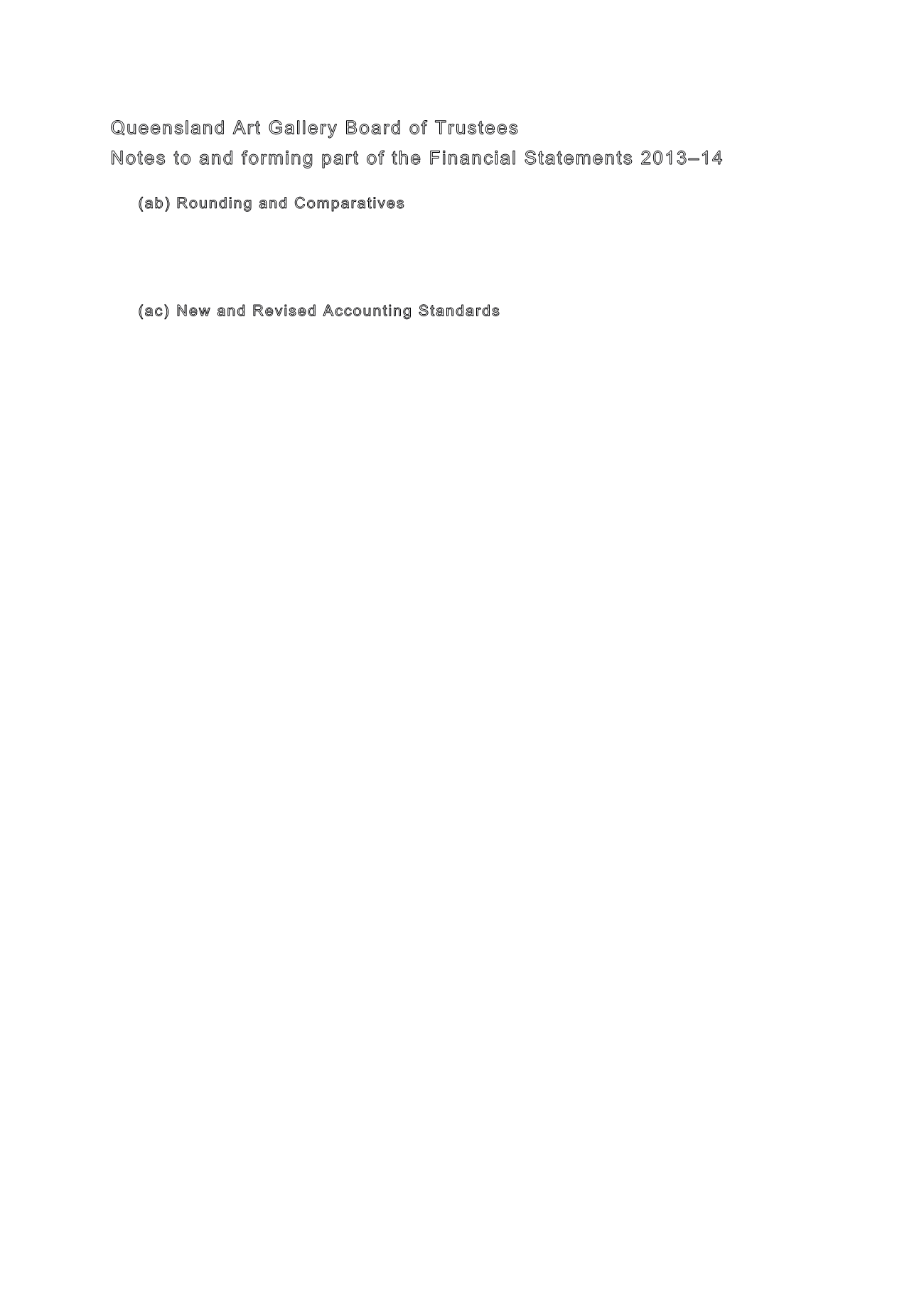

Queensland Art Gallery Board of Trustees Annual Report 2013–14
FINANCIAL STATEMENTS
PART B
16
16
Queensland Ar t Gallery Board of Trustees
Notes to and forming par t of the Financial Statements 2013–14
(ab) Rounding and Comparatives
Amounts included in the financial statements are in Australian dollars and have been
rounded to the nearest $1,000 or, where that amount is $500 or less, to zero unless
disclosure of the full amount is specifically required. Comparative information has been
restated where necessary to be consistent with disclosures in the current reporting period.
(ac) New and Revised Accounting Standards
The Gallery did not voluntarily change any of its accounting policies during 2013–14.
Australian Accounting Standard changes applicable for the first time for 2013–14 have
had minimal effect on the Gallery’s financial statements, as explained below.
AASB 13 Fair Value Measurement
became effective from reporting periods beginning on or
after 1 January 2013.
AASB 13
sets out a new definition of ‘fair value’ as well as new
principles to be applied when determining the fair value of assets and liabilities. The new
requirements will apply to all of the Gallery’s assets and liabilities (excluding leases) that are
measured and/or disclosed at fair value or another measurement based on fair value. The
impacts of AASB 13 relate to the fair value measurement methodologies used and financial
statement disclosures made in respect of such assets and liabilities.
The Gallery reviewed its fair value methodologies (including instructions to valuers, data
used and assumptions made) for all items of property, plant and equipment measured at
fair value to determine whether those methodologies complied with AASB 13. No change
in valuation arose from AASB 13 given that fair value methodologies were already
compliant.
AASB 13 has required an increased amount of information to be disclosed in relation to
fair value measurements for both assets and liabilities. For those fair value
measurements of assets or liabilities that are based substantially on data that is not
observable (i.e. accessible outside the Gallery), the amount of information disclosed has
significantly increased. Note 1 (k) explains some of the principles underpinning the
additional fair value information disclosed. Most of this additional information is set out in
Notes 16 and 28.
A revised version of AASB 119
Employee Benefits
became effective from reporting
periods beginning on or after 1 January 2013. The definition of ‘short-term employee
benefits’ has now been revised to include all employee benefits expected to be settled
wholly before 12 months. The change in the definition has meant that annual leave
liabilities that previously would have been regarded as ‘short-term employee benefits’ are
now measured and classified as ‘other long-term employee benefits’. Changes to the
definition and measurement of ‘termination benefits’ may also impact the Gallery in future
periods, but the impact is likely to be immaterial as traditionally the Gallery has rarely
offered such termination benefits.
The revised AASB 119 also includes changed requirements for the measurement of
employer liabilities/assets arising from defined benefit plans, and the measurement and
presentation of changes in such liabilities/assets. The Gallery makes employer
superannuation only to QSuper defined benefits plans, and the corresponding QSuper
employer benefit obligation is held by the State. Therefore those changes to AASB 119
will have no impact on the Gallery.
AASB 1053
Application of Tiers of Australian Accounting Standards
became effective
from reporting periods beginning on or after 1 July 2013. AASB 1053 establishes a
differential reporting framework for those entities that prepare general purpose financial
statements, consisting of two Tiers of reporting requirements — Australian Accounting
Standards (commonly referred to as ‘Tier 1’) and Australian Accounting Standards –
Reduced Disclosure Requirements (commonly referred to as ‘Tier 2’). Tier 1
requirements comprise the full range of AASB recognition, measurement, presentation
and disclosure requirements that are currently applicable to reporting entities in Australia.
















